Parametric Urbanism and Environment Optimization: Toward a Quality Environmental Urban Morphology
Abstract
1. Introduction
2. Materials and Methods
2.1. Data Collection
2.1.1. Material Data Types
- FARFAR acts as a quantized variable to represent the physical environment. It is the measurement of a building’s floor area in relation to the size of the lot/parcel that the building is located on. FAR value reflects building density, urban land usage, and the health of the urban atmosphere.
- Air path widthAir path width reflects the wind flow corridors between buildings or constructions. As per Ng (2010), the width of the street must be wider than the height of buildings; otherwise, skimming flow will dominate [16].
- Road hierarchyRoad hierarchy helps to estimate vehicle flow. A high-grade road suggests high levels of auto-transportation. This may result in high carbon emissions and pollution.
- InfrastructureInfrastructure describes municipal service facilities. To a certain extent, it indicates the population gathering. Ample infrastructure reflects high-level artificial activities and clusters of communities.
- Street canyonStreet canyon is defined by the width of a specific street and the building height along that street. The ratio of depth-to-width impacts natural ventilation. The higher this ratio, the weaker the wind at the ground level [16].
- Building heightBuilding height reflects the skylines from a morphology perspective, as well as city ventilation from an environmental one. Taller buildings catch the wind passing through the city and downwash it into the city.
2.1.2. Geographic Data Types
2.1.3. Data Normalization
2.2. Model Generation
2.2.1. Algorithm Logic
2.2.2. Software and Scripts
2.2.3. Parametric Modeling
2.3. Environmental Simulation and Examination
3. Results and Discussion
3.1. A Parametric Modeling System for Environmental Urban Morphology
- EfficiencyThe system synchronizes human thoughts with parametric models—avoiding the investment of time and human resources to generate manual models.
- FlexibilityIt has the capability to support the analysis of multiple morphology types by adjusting parameter values or data. Parametric modeling systems have potentially wide-ranging applicability, from parametric urbanism to environmental sustainability.
- VisualizationUrbanism strategies become more foreseeable and visible. Strategies no longer exist only in text descriptions and static images. Parametric models provide vivid pictures for planners, urban designers, environmentalists, architects, municipalities, developers, and neighborhoods and communities. The models also can connect with networks for public participation toward a rational and practicable environmental urban morphology scheme.
3.2. An Alternative Approach to Environment Optimization
4. Conclusions
Author Contributions
Funding
Institutional Review Board Statement
Informed Consent Statement
Data Availability Statement
Conflicts of Interest
References
- Karle, D.; Kelly, B. Parametric Thinking. In Proceedings of the Parametricism ACADIA Regional 2011 Conference, Lincoln, NE, USA, 10–20 March 2011; Cheon, J., Hardy, S., Hemsath, T., Eds.; University of Nebraska Press: Lincoln, NE, USA, 2011. [Google Scholar]
- Kolarevic, B. Architecture in the Digital Age Design and Manufacturing; Taylor & Francis: New York, NY, USA; London, UK, 2005. [Google Scholar]
- Pinto, G.M.; Vieira, A.P.; Neto, P.L. Parametric Urbanism as Digital Methodology: An Urban Plan in Beijing. In Proceedings of the eCAADe Regional International Workshop, Porto, Portugal, 4–5 April 2013. [Google Scholar]
- Gu, N.; Yu, R.; Behbahani, P.A. Parametric Design: Theoretical Development and Algorithmic Foundation for Design Generation in Architecture. In Handbook of the Mathematics of the Arts and Sciences; Springer: Cambridge, UK, 2018. [Google Scholar]
- Nagy, D. Urban Magazine: Towards a Collective Purpose; Publication of the Students of Columbia University: Columbia, SC, USA, 2009. [Google Scholar]
- Leach, N. Digital Cities AD: Architectural Design; Wiley & Sons: London, UK, 2009. [Google Scholar]
- Sadollah, A.; Nasir, M.; Geem, Z.W. Sustainability and Optimization: From Conceptual Fundamentals to Applications. Sustainability 2020, 12, 2027. [Google Scholar] [CrossRef]
- Saleh, M. Using the Tools of Parametric Urbanism: Toward a More Responsive Environmental Urban Morphology. Master’s Thesis, University of Alexandria, Alexandria, VA, USA, 2012. [Google Scholar]
- Salat, S.; Adhitya, S. Workshop on High Density Cities and Urban Morphology; Urban Morphology and Complex Systems Institute: Paris, France, 2009. [Google Scholar]
- Rodwell, D. Urban Morphology, Historic Urban Landscapes and the Management of Historic Cities. Urban Morphol. 2009, 13, 78–79. [Google Scholar]
- Parolek, D.G.; Parolek, K.; Crawford, P.C. Form-Based Codes: A Guide for Planners, Urban Designers, Municipalities, and Developers; John Wiley & Sons: Hoboken, NJ, USA, 2008. [Google Scholar]
- Carmona, M.; Punter, J. The Design Dimension of Planning: Theory, Content, and Best Practice for Design Policies; Taylor and Francis: Oxford, UK, 1997. [Google Scholar]
- Imrie, R.; Street, E. The Attitudes of Architects towards Planning Regulation and Control. In The Codification and Regulation of Architect’s Practices; King’s College London: London, UK, 2006. [Google Scholar]
- Marshall, S. Streets and Patterns; Spon Press: New York, NY, USA, 2005. [Google Scholar]
- National Construction Committee of China. Provisions of Urban Planning Quota Indicators; National Construction Committee: Beijing, China, 1980. [Google Scholar]
- Ng, E. Designing for Urban Ventilation. In Designing High-Density Cities; Earthscan: London, UK, 2010. [Google Scholar]
- Anderson, M. Global Position Tech Inspires Do-It-Yourself Mapping Project. Available online: https://web.archive.org/web/20090211044643/http:/news.nationalgeographic.com/news/2006/10/061018-street-maps.html (accessed on 10 September 2020).
- Zhang, Y. Parametric Modeling for Form-Based Planning in Dense Urban Environments. Sustainability 2019, 11, 5678. [Google Scholar] [CrossRef]
- Zhang, Y. Enhancing Form-Based Code: A Parametric Approach to Urban Volumetric Morphology in High-density Cities. Ph.D. Thesis, Victoria University of Wellington, Wellington, New Zealand, 2019. [Google Scholar]
- Rogers, H. Theory of Recursive Functions and Effective Computability; The Massachusetts Institute of Technology Press: Cambridge, MA, USA, 1987. [Google Scholar]
- Scott, M.L. Programming Language Pragmatics; Morgan Kaufmann Publishers: Burlington, MA, USA, 2009. [Google Scholar]
- Tausworthe, R.C. Standardized Development of Computer Software Part One Methods; Prentice–Hall, Inc.: Hoboken, NJ, USA, 1977. [Google Scholar]
- Knuth, D. Semi-numerical Algorithms. In The Art of Computer Programming; Addison Wesley: Boston, MA, USA, 1969. [Google Scholar]
- Schumacher, P. Parametricism: A New Global Style for Architecture and Urban Design. Archit. Des. 2009, 79, 14–23. [Google Scholar] [CrossRef]
- Reilly, C. What is Grasshopper. Available online: https://www.lynda.com/Grasshopper-tutorials/What-Grasshopper/174491/194087-4.html (accessed on 24 December 2020).
- Davis, D. A History of Parametric. Available online: http://www.danieldavis.com/a-history-of-parametric/ (accessed on 18 July 2020).
- Wei, R.; Song, D.; Wong, N.H.; Martin, M. Impact of Urban Morphology Parameters on Microclimate. Procedia Eng. 2016, 12, 142–149. [Google Scholar] [CrossRef]
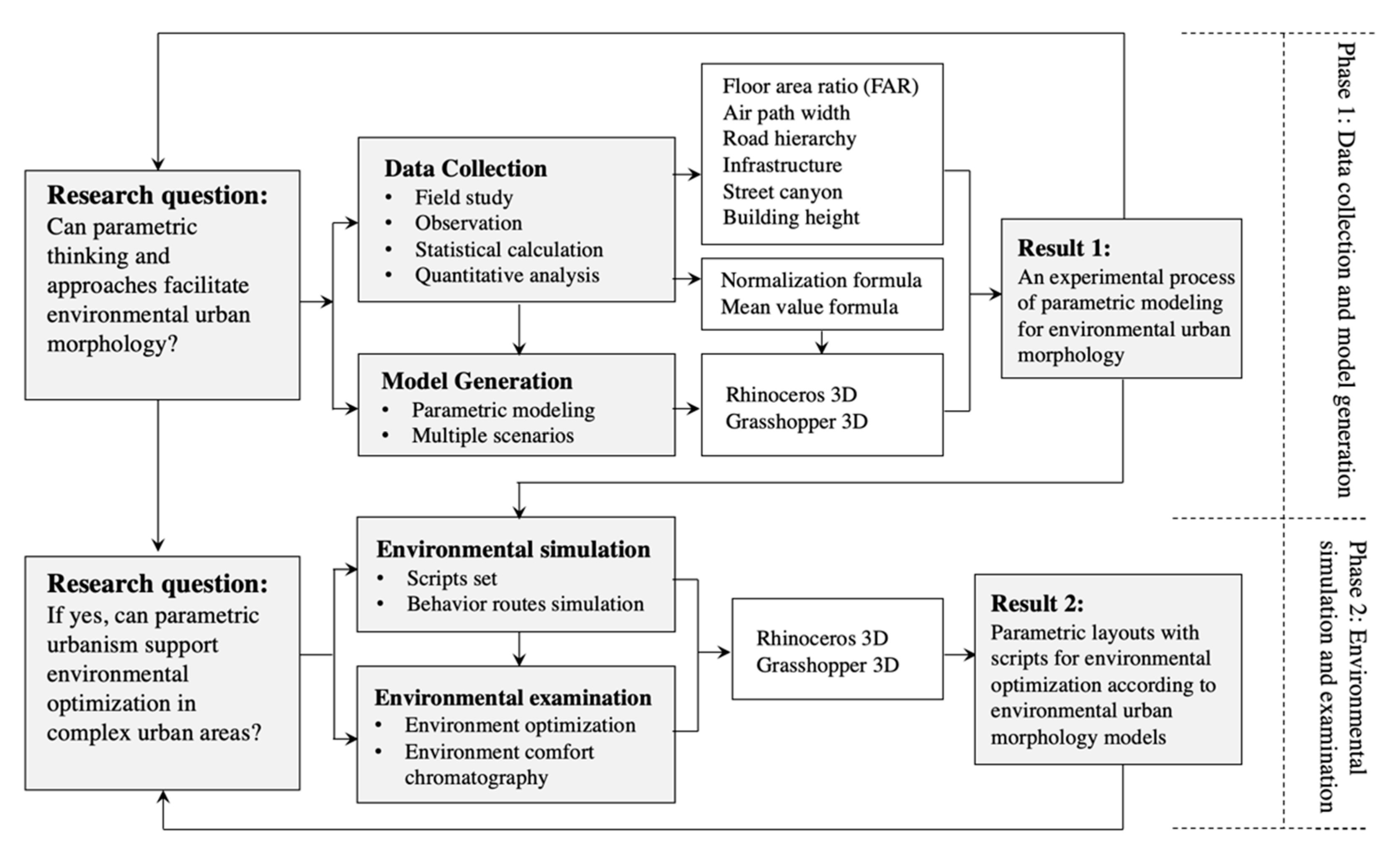
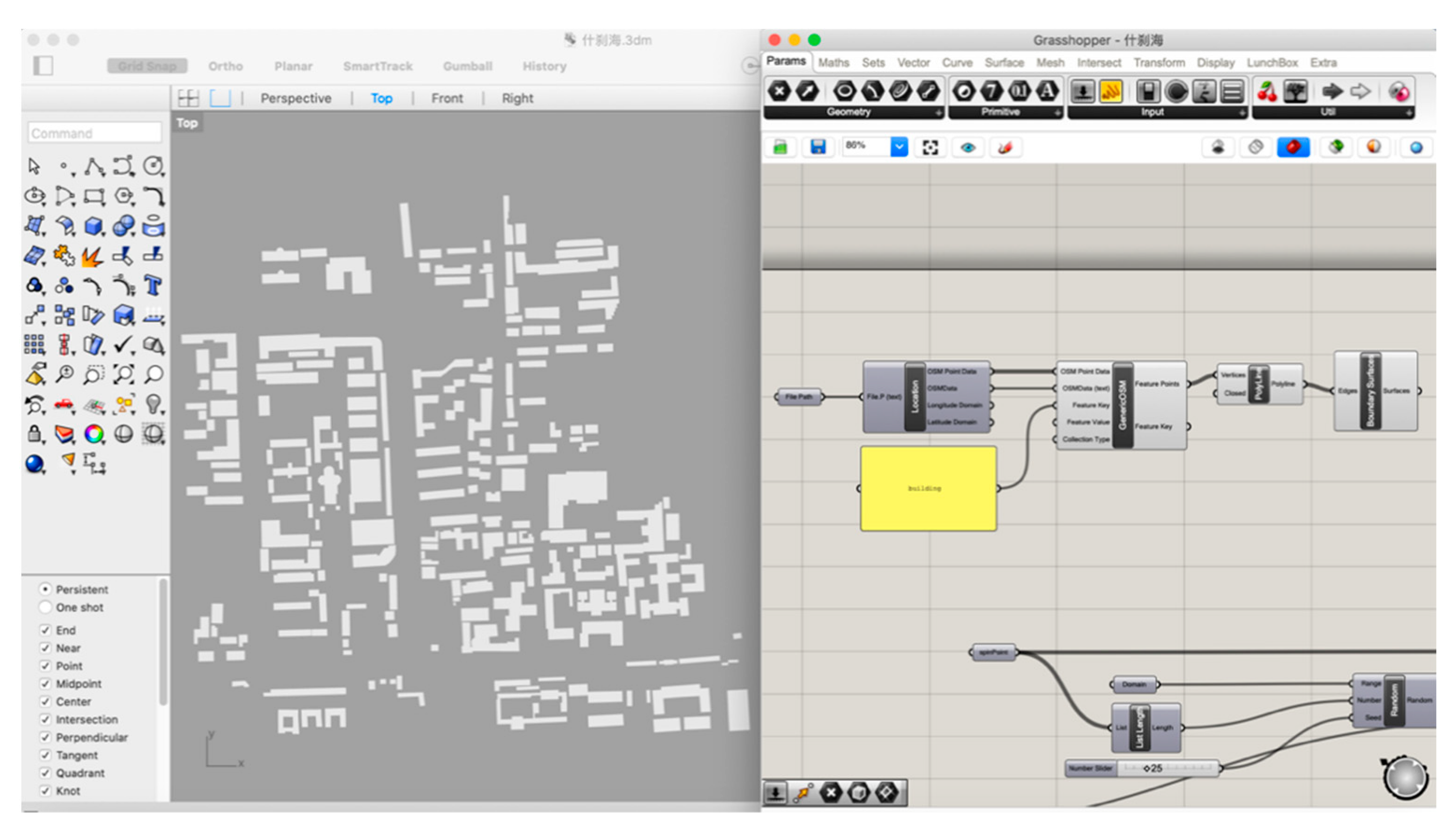
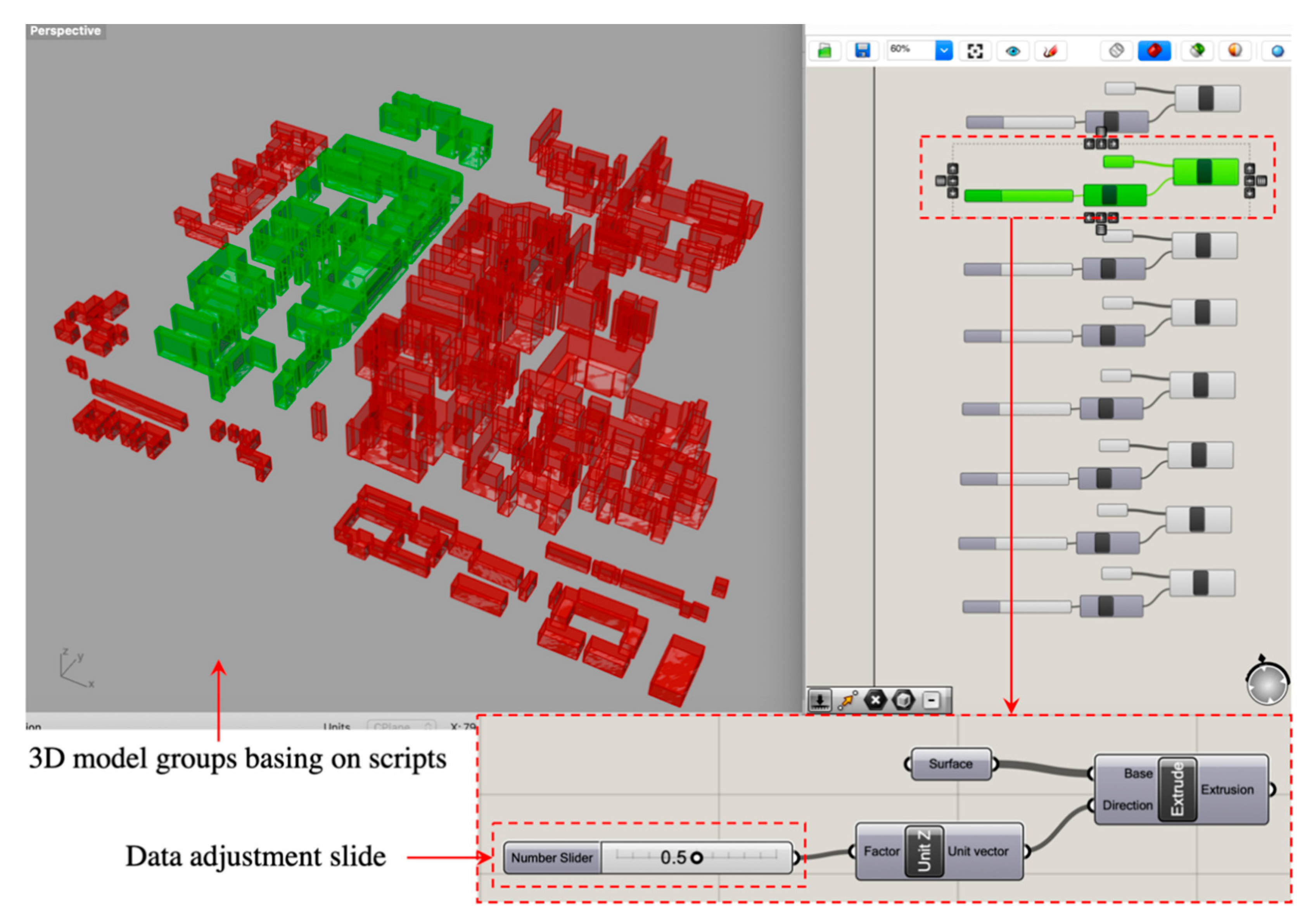

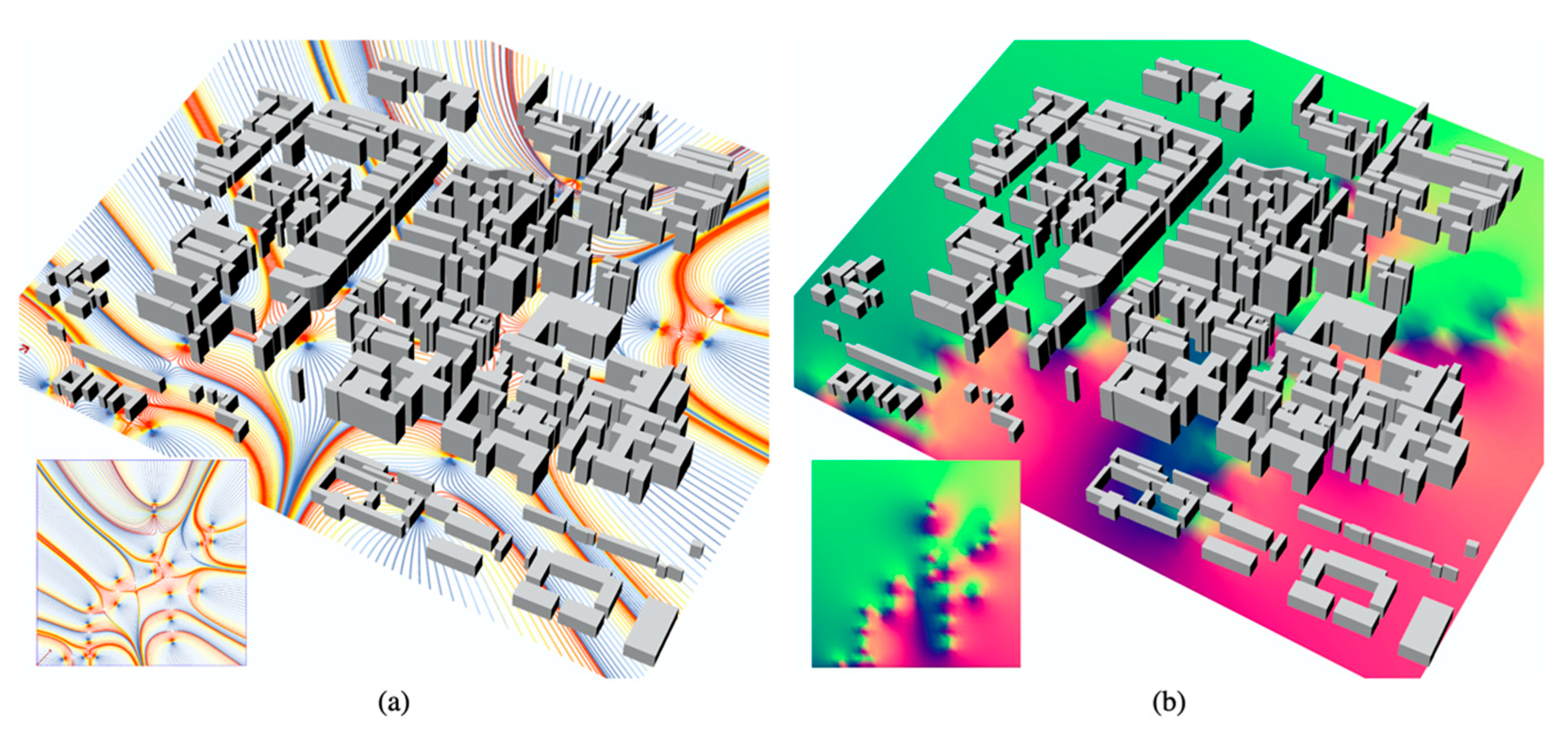
| Urban Morphology Aspect | Data Type | Urban Morphology Aspect | Data Type | Urban Morphology Aspect | Data Type | |
|---|---|---|---|---|---|---|
| Building Complex | FAR | Street Networks | Air Path Width (m) | Open Space | Infrastructure | |
| Building Height (m) | Road Hierarchy | Street Canyon | ||||
| Road Hierarchy Grade | ||||||
| Grade | Speed (km/h) | Lane | Motorway Width (m) | Total Width (m) | Median Strip | |
| 1 | <30 | ≥2 | 3.50 | 16–30 | N/A | |
| 2 | 30–40 | ≥2 | 3.50 | 20–40 | N/A | |
| 3 | 40–60 | ≥4 | 3.50 | 30–60 | √ | |
| 4 | 60–80 | ≥4 | 3.75 | 40–70 | √ | |
| The above grading manners are based on the provisions of urban planning quota indicators [15] | ||||||
| Infrastructure Grade | ||||||
| Grade | Description | |||||
| 1 | Fire hydrant, plumbing well, trash can | |||||
| 2 | Fire hydrant, plumbing well, trash can, substation box, border tree | |||||
| 3 | Fire hydrant, plumbing well, trash can, substation box, border tree, streetlamp, bench | |||||
| 4 | Fire hydrant, plumbing well, trash can, substation box, border tree, streetlamp, bench, street art, etc. | |||||
| The above grading manners are based on the ample degrees of the current situation | ||||||
| Location | No. | FAR | Air Path Width (m) | Road Hierarchy | Infrastructure | Street Canyon | Building Height (m) | Average |
|---|---|---|---|---|---|---|---|---|
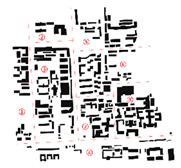 | Part 1 | 0.00 | 0.00 | 0.00 | 0.00 | 0.00 | 0.00 | 0.00 |
| Part 2 | 0.70 | 0.33 | 0.50 | 0.33 | 0.33 | 0.25 | 0.41 | |
| Part 3 | 0.90 | 0.33 | 1.00 | 0.67 | 0.33 | 0.25 | 0.58 | |
| Part 4 | 0.43 | 0.67 | 1.00 | 0.67 | 0.33 | 0.50 | 0.60 | |
| Part 5 | 0.55 | 1.00 | 1.00 | 1.00 | 0.33 | 0.50 | 0.73 | |
| Part 6 | 1.00 | 1.00 | 1.00 | 1.00 | 1.00 | 1.00 | 1.00 | |
| Part 7 | 0.85 | 1.00 | 1.00 | 1.00 | 0.67 | 0.75 | 0.88 | |
| Part 8 | 0.97 | 1.00 | 0.50 | 0.67 | 0.75 | 0.75 | 0.77 |
Publisher’s Note: MDPI stays neutral with regard to jurisdictional claims in published maps and institutional affiliations. |
© 2021 by the authors. Licensee MDPI, Basel, Switzerland. This article is an open access article distributed under the terms and conditions of the Creative Commons Attribution (CC BY) license (http://creativecommons.org/licenses/by/4.0/).
Share and Cite
Zhang, Y.; Liu, C. Parametric Urbanism and Environment Optimization: Toward a Quality Environmental Urban Morphology. Int. J. Environ. Res. Public Health 2021, 18, 3558. https://doi.org/10.3390/ijerph18073558
Zhang Y, Liu C. Parametric Urbanism and Environment Optimization: Toward a Quality Environmental Urban Morphology. International Journal of Environmental Research and Public Health. 2021; 18(7):3558. https://doi.org/10.3390/ijerph18073558
Chicago/Turabian StyleZhang, Yingyi, and Chang Liu. 2021. "Parametric Urbanism and Environment Optimization: Toward a Quality Environmental Urban Morphology" International Journal of Environmental Research and Public Health 18, no. 7: 3558. https://doi.org/10.3390/ijerph18073558
APA StyleZhang, Y., & Liu, C. (2021). Parametric Urbanism and Environment Optimization: Toward a Quality Environmental Urban Morphology. International Journal of Environmental Research and Public Health, 18(7), 3558. https://doi.org/10.3390/ijerph18073558





